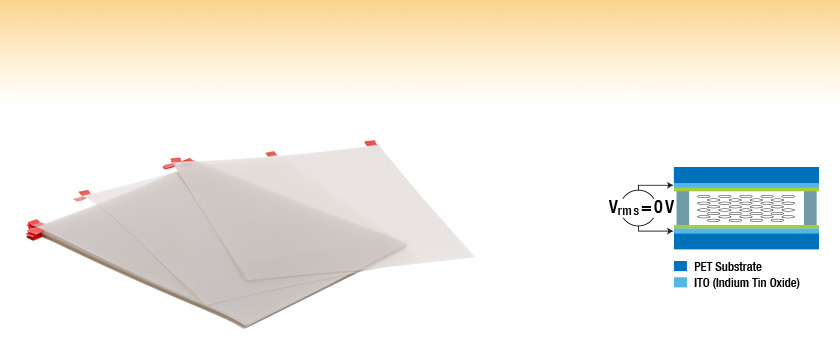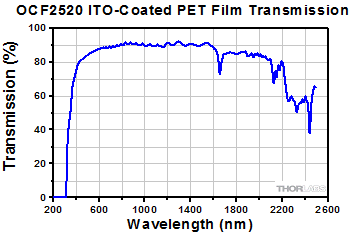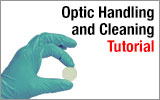ITO-Coated PET Film

- Pack of Twenty 250 mm x 200 mm x 0.2 mm Polyethylene Terephthalate (PET) Film Sheets
- Conductive Indium Tin Oxide (ITO) Coating on One Side
- High Transmission in the 400 nm - 2110 nm Wavelength Range
OCF2520
Pack of Twenty Sheets
Application Idea
ITO-Coated PET can be used as the conductive layer in a liquid crystal device.

Please Wait
| Item # | OCF2520 |
|---|---|
| Wavelength Range | 400 - 2110 nm |
| Material | Polyethylene Terephthalate (PET) |
| Coating (One Side) | Indium Tin Oxide (ITO) |
| ITO Sheet Resistance Range* | 350 - 500 Ω/sq |
| Sheet Size | 250 mm × 200 mm (9.84" × 7.87") |
| Size Tolerance | ±5 mm |
| Sheet Thickness | 0.2 mm (7.87 mils) |
| Thickness Tolerance | ±0.01 mm |
| Surface Quality | |
| Maximum Operating Temperature | 120 °C |

Click to Enlarge
Click Here for Raw Data
Typical transmission of one OCF2520 Sheet. Please note that the data given is typical, and performance may vary slightly from lot to lot.
Thorlabs' OCF2520 is a pack of twenty optically clear, Polyethylene Terephthalate (PET) Film Sheets that have a conductive Indium Tin Oxide (ITO) coating deposited on one side. The coating has a sheet resistance of 350 to 500 Ω/sq*, and each sheet is highly flexible and temperature resistant up to 120 ºC.
Measuring 250 mm x 200 mm x 0.2 mm (L x W x T) in size, our ITO-coated PET sheets provide high transmission in the 400 nm - 2110 nm spectral range. Please see the transmission plot to the right for details. The film has a surface quality of 40-20 scratch-dig on the ITO coated side and 60-40 scratch-dig on the uncoated side.
Each sheet is protected on both sides by a thin film that can be pulled off using the included red tabs. A multimeter can be used to verify the side with the conductive ITO coating. These films can be cleaned with ethanol.
Applications
ITO-coated PET films can be used in a number of different applications due to their high optical transmission and conductivity. They can be used in liquid crystal devices to provide a transparent, conductive layer that accepts the applied voltage used to realign the liquid crystal cells. The sheets are also commonly used as components for touchscreens, position sensors, electroluminescent lamps, and electrophoretic displays, as well as in electromagnetic shielding applications.
*Sheet Resistance
Sheet resistance is defined as ρ/t: the resistivity (Ω*m) divided by the thickness (m) of the conductive ITO coating. The units are given as Ω/sq (Ohms per square) to differentiate the sheet resistance from the total resistance of some area of the film. The resistance of these films is given by:
R = Rs * (L/W)
where L and W are the length and width of the film, respectively, and Rs is the sheet resistance. For a square of the thin film, where L = W, the resistance of the film is equal to the sheet resistance regardless of size.
| Posted Comments: | |
Masami Kobayashi
(posted 2024-05-20 10:45:42.393) We bought this PET ITO(OCF2520).
We think good product.
Please tell me specification of surface roughness(Ra and Rz). cdolbashian
(posted 2024-05-24 10:29:52.0) Thank you for contacting Thorlabs. We currently do not have a specification for the surface roughness of these sheets. Gerburg Schider
(posted 2024-02-08 16:13:43.443) Dear Team,
just for info:
we bought this PET ITO foil.
It has a good conductivity and is clean.
but the ITO suface has protruding elements distributed on the surface >200nm high, rather 400nm.
this is too high for our application.
Could you mail me the nominal thickness of the ITO layer?
We will keep the sheets for some possible later application.
Best regards
Gerburg jpolaris
(posted 2024-02-08 02:50:03.0) Thank you for contacting Thorlabs. The ITO later thickness is nominally within 90 Å - 150 Å, which is 9 nm - 15 nm. This is significantly less than 200 nm. I have reached out to you directly to discuss this further and to resolve any issues you might be having if this film is not meeting spec. Rasna Veetil
(posted 2022-10-28 19:31:45.13) Could you please help me to know which UV adhesive gives best adhesion of PET film to glass substrate, or between two PET films. cdolbashian
(posted 2022-11-08 02:20:03.0) Thank you for contacting Thorlabs. NOA series adhesive is a good choice. (e.g. NOA68, found here: https://www.thorlabs.com/thorproduct.cfm?partnumber=NOA68) We will contact you via email with more details. Naga Adithya Chandra Pandurangi
(posted 2022-07-15 10:34:10.01) Could you please tell me what are the cleaning instructions for this film before use ? Can we use ethanol or other organic solvents to clean the surface? Can you let me know the brief instructions please?
Thank you. cdolbashian
(posted 2022-07-19 02:59:39.0) Thank you for contacting Thorlabs. The surface of OCF2520 is Polyethylene Terephthalate (PET) Film, which can be cleaned with ethanol. For detailed cleaning procedures, please refer to the following link: https://www.thorlabs.com/newgrouppage9.cfm?objectgroup_id=9025 Julia Hsu
(posted 2022-01-17 15:09:41.357) Is the transmission plot measured referenced to PET substrate or air? YLohia
(posted 2022-01-20 03:22:42.0) Thank you for contacting Thorlabs. The plot refers to the typical transmission of one OCF2520 sheet (the PET film coated with ITO coating). AMIT BAGHEL
(posted 2022-01-05 12:32:50.023) I require the sheet resistance of exact 400 ohm/sq. Is it possible. Rest is fine with me. cdolbashian
(posted 2022-01-10 11:56:44.0) Thank you for contacting Thorlabs with this inquiry. It is possible, although we would require a fairly large MOQ. We will reach out to you directly via email to discuss this. Darwyn Ward
(posted 2021-12-08 16:23:46.117) Is the PET used in this product crystalline, semi-crystalline or amorphous? YLohia
(posted 2021-12-15 11:28:08.0) Thank you for contacting Thorlabs. The PET used is amorphous. user
(posted 2021-05-05 22:07:01.307) What is the thickness of the ITO film on PET?
And
What is the resistivity of the ITO used? YLohia
(posted 2021-05-07 10:47:19.0) Thank you for contacting Thorlabs. The ITO layer has not been measured directly, but should be around 90-150 Å. The resistivity ranges between 3.15E-6 and 7.5E-6 Ω/m. Sean Tan
(posted 2021-02-11 10:57:41.13) Hello, what is the PET's Tg for OCF2520? YLohia
(posted 2021-03-25 03:40:48.0) Hello, thank you for contacting Thorlabs. We will reach out to you directly. Ladislav Vyklicky
(posted 2020-11-30 04:22:00.007) Hello,
We use OCF2520 to heat an optic chamber. The PET film is placed in between two glasses - when we assemble the glass and the PET film "maps" form at the interface - perhaps due to some sticky material that covers the PET film (after foil detachment). Is there a way to avoid “map” formation?
Sincerely yours Ladia YLohia
(posted 2020-12-09 11:05:07.0) Hello Ladia, thank you for contacting Thorlabs. There is no sticky material on ITO film. The phenomenon you mentioned is caused by surface electrostatic interaction and the residual stress in the film. Another reason may be due to the stress caused during the assembly process and aging. The "map" formation is also related to the surface flatness of the glasses itself and a clean operation process. user
(posted 2020-10-21 23:42:01.79) I just wanted to know that what material is used to make the protective covering that comes on the top of ITO sheet YLohia
(posted 2020-11-06 09:44:19.0) Thank you for contacting Thorlabs. The protective film on top of the ITO is PE plastic. Anayeli Flores
(posted 2020-07-14 15:40:36.04) What is the crystallinity of the ITO film (amorphous, poly crystalline, etc.)? I would like etch these films but I have read that etch rate is determined by the crystallinity of the ITO thin film. Thank you for your time. YLohia
(posted 2020-07-20 10:44:22.0) Thank you for contacting Thorlabs. ITO is a non-crystalline (amorphous) film. Upendra Adhikari
(posted 2020-06-29 16:20:04.757) Hello, what is the seed layer in the coating material? Does this affect overall conductivity of the ITO ? YLohia
(posted 2020-07-06 09:23:48.0) Hello, thank you for contacting Thorlabs. Our ITO films do not have seed layers. user
(posted 2020-05-20 14:27:25.553) Hello, is this product suitable for creating resistive touch-screens?
Thank you. YLohia
(posted 2020-05-21 08:54:34.0) Hello, thank you for contacting Thorlabs. ITO coated PET Films have been used in flexible screen and touchscreen applications. If you have further questions, please feel free to email your local Thorlabs Tech Support team regarding this. Andreas Frölich
(posted 2020-04-01 11:41:18.193) would you have this as a thinner film, e.g. 50 µm thick in total with a sub-micron ITO layer on top of it?
Would you also be able to supply this with Polycarbonate as the substrate in place of PET? mdiekmann
(posted 2020-04-07 09:48:46.0) Response from Meike at Thorlabs: Thank you for contacting us! There is some possibility for customization, but it will depend on the required quantities and specifications. Since you opted not to be contacted, please reach out to europe@thorlabs.com in case you would like to discuss this further. Tanvi Upreti
(posted 2020-03-09 11:52:16.527) Hi,
would it be possible to get an exact resistance of 10 ohm/sq for the ITO sheets as well as the RMS roughness of the ITO. Thanks! YLohia
(posted 2020-03-12 08:26:30.0) Hello, thank you for contacting Thorlabs. We have reached out to you directly to discuss this further. user
(posted 2018-05-30 11:57:18.21) Hello, is there a maximum power input to the ITO heater? Max W/cm2? Thanks! YLohia
(posted 2018-06-01 08:29:21.0) Hello, we have yet to perform damage threshold testing on these units so, unfortunately, we don't have any recommendations at the moment for the maximum power density that this ITO heater can handle. dominic.lepage
(posted 2016-10-27 15:44:29.5) Hi,
Would it be possible to have the thickness of ITO and PET on this film ?
Thanks! tfrisch
(posted 2016-11-01 10:41:08.0) Hello, thank you for contacting Thorlabs. The ITO layer has not been measured directly, but it is around 90-150 Å. The thickness of the PET substrate is ~0.188 mm. |
 Products Home
Products Home









 ITO-Coated PET Film
ITO-Coated PET Film